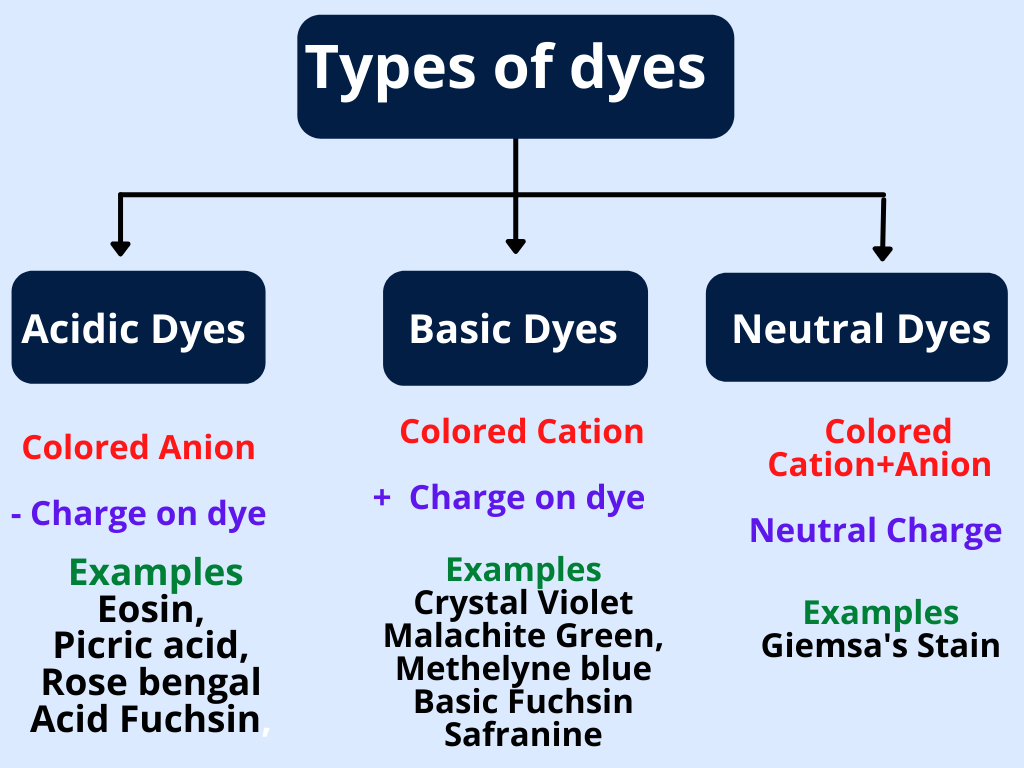Benzene is a cyclic compound present in coal tar and natural crude oil. Most of the dyes are the derivative of this cyclic compound benzene. So dyes are also called coal tar dyes. Microbiologists use different types of dyes and stains in microbiology for various staining techniques. The term dye and stain are used interchangeably. There is a difference in characteristics of the dye and stain.
Definition of the dye:
A dye is an organic compound to which auxochrome and chromophore groups are attached to the benzene ring.
The auxochrome and chromophore groups are nothing but the chemical groups attached to benzene rings.
Chromophore: The chromophore group provides color to the benzene.
Auxochrome: The auxochrome group causes electrolytic dissociation of the compound.
This group causes ionization of the dye. It provides the salt-forming capability to the dye.
Chromogen: The chromogen is the compound of a benzene ring with chromophore groups. Chromogen compounds lack auxochrome groups. Chromogen has the color, but it is not called a dye because chromogen doesn’t dissociate. It doesn’t have an affinity to bind to cells and tissues.
To act as a dye the electrolytic dissociation of the compound is necessary. The dye can stain the specimen when auxochrome and chromophore groups are present.
Dyes are nothing but salt. Electrolytic dissociation of this salt forms positive and negative ions. After dissociation, a positive or negative charge appears on the dye part of the molecule. If the negative charge (anion) is there on the dye part of the molecule then it acts as Acid dyes. If the positive charge (cation) is there on part of the molecule then it acts as basic dyes.
In this way After ionization acidic dyes have color in their Anion. So you can call Acidic dye as colored anions. Whereas after ionization basic dyes have color in their cation. So you can call basic dye as colored cations.
Different types of dyes and stains :
Three types of dyes are basic dyes, acidic dyes and neutral dyes.

Basic dyes:
During ionization basic dyes have positive charge that’s why basic dyes are cationic dyes. Bacteria also have the negative charge on its molecules like nucleic acid, protein, and cell surface. Because of this Basic dyes have affinity towards negatively charged molecules and cell surface. Therefore Bacteria attract basic dyes. Simple staining require basic dyes. In staining method basic dyes are used more than acidic dyes. Examples of basic dyes are : crystal violet, , malachite green. Methylene blue, basic fuchsin, safranine.
You can remember the names of basic dyes using a sentence.
CV Mala is MBBS.
CV – Crystal Violet
Mala – Malachite Green
MBBS – Methylene Blue, Basic fuchsin, Safranine.
Acidic dyes:
During ionization acidic dyes have negative charge that’s why acidic dyes are anionic dyes. Acid dyes don’t have affinity towards bacterial cells during staining. This is because bacterial cells and acid dyes both have negative charge. Because of this there is repulsion between dye and bacterial cell. These dyes don’t stain the bacteria instead, they stain the background. One of the staining technique where staining of background occurs negative staining.
Acid Fuchsin, Eosin, Rose bengal etc.
Neutral dyes :
Neutral dyes are combination of both acid dye and basic dye.
In this type of stain both anion and cation have color as as result net charge is neutral.
Neutral dyes stain nucleic acid.
Example Giemsa stain.
Definition of stain:
Stains are chemical reagents or dyes that impart color to biological specimens such as cells and tissues during staining. The Stain increase the contrast between the biological specimen and background.
- Dyes are coloring agent for use of general purpose such as coloring textile, coloring wall etc.
- Stains are coloring agents for coloring of biological specimen, tissues during staining.
Difference between dye and stain :
| Dyes | Stain |
| Dyes are used to color general items like textile | stains are used to color biological samples |
| Dyes are more soluble | stains are less soluble |
| Dyes are prepared with less specification | stains are prepared with more specification |
| Dyes are crude in nature | Stains are pure form in nature |
| dyes are smaller molecules | stains are larger molecules |
| Dyes are cheaper in cost | stains are costly |

Thank you. Very informative.
Without staining can’t microorganisms be visible in microscope
Splendid